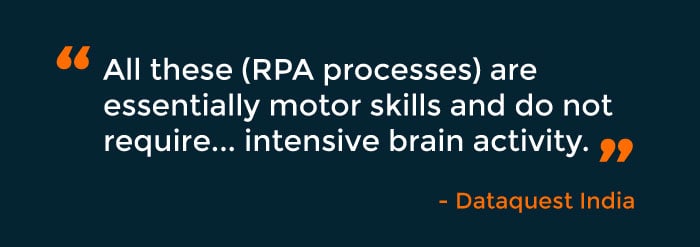Robotic Process Automation (RPA) is a critical component of any modern process automation platform.
Other process technologies (workflow, document generation, process mapping, etc.), can play a key role in dealing with processes that involve human interaction with structured and unstructured data. The primary use of RPA, meanwhile, is to digitize and automate repetitive, manual, and back-office tasks typically involving structured data. Because of its quantifiable ROI and quick time-to-value, RPA is gaining traction in operations groups that service finance, accounting, procurement, customer service, call centers, and HR across a variety of industries.
RPA’s current surge in popularity is largely due to its ability to remove or replace people from processes by mimicking their keystrokes. The RPA robot is “trained” to interact with applications via their UIs, using the same credentials a human would – not (or usually not) through APIs and/or web services. Tasks that entail multiple interactions with multiple systems of record are common targets for RPA.
RPA is gaining traction across industries including financial services, healthcare, IT, manufacturing, retail, telecoms, transportation, and utilities. Some typical use cases are discussed in a recent report from Deloitte Development.

RPA Drivers
This is only the latest in a series of automation solutions that began with screen scraping and terminal emulation and has evolved through macros and various forms of business process automation, management, and outsourcing. All have been driven by similar needs and goals, including increased efficiency, reduced costs, fewer errors, improved policy and regulatory compliance, and the like.
RPA’s UI-based approach makes it well suited for legacy enterprise applications that predate the relatively recent emergence of APIs. Enterprises “see RPA as part of their automation strategy” because it “boosts productivity with minimal process change [and] brings an easy-to-calculate ROI,” Forrester said in their February 2017 Wave report.
“You don’t have to do any data-integration projects or have a lot of cross-department meetings,” Forrester’s Craig Le Clair told CFO.com last September. RPA “really is just about understanding the specific clicks that a human is making and substituting a software routine, a bot, to eliminate a lot of non-value-added steps.”
Frances Karamouzis, Gartner analyst and research VP, recently told ZDNet. “They’re also easy to use and have a relatively low cost. For all those reasons [RPA] has by far the highest adoption of automation tools that we’ve seen.”

RPA Limitations
As we mentioned previously, RPA is one key component of an IPA platform. RPA can be very effective in handling the multitude of rote, repetitive tasks that have yet to be automated particularly when dealing with legacy systems, but it is often viewed as being “brittle” and “limited” in terms of its capabilities.
Simply applying RPA alone to a broken and inefficient process will not fix it. RPA will, in the best case, mask the underlying issues and, in the worst case, exacerbate them. Robotic Process Automation is at its best when used in conjunction with other Intelligent Process Automation capabilities. Ideally, companies should focus first on addressing the root causes of their process or technology inefficiencies, then apply RPA to maximize the benefits.
It is important to remember that RPA is not a process automation solution and does not bring the end-to-end process optimization that would be gained from a complete process management and automation portfolio approach that combines the following six key capabilities
Wrapping RPA into a portfolio of solutions that includes workflow, forms, and document generation as well as machine and process intelligence can ensure sustainable long-term savings and efficiency by automating, orchestrating and optimizing entire business processes – not just the rote data entry component of a given process.
